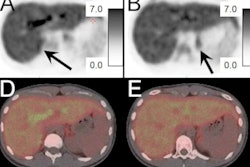Thursday, December 2 | 1:30 p.m.-2:30 p.m. | SSNMMI08-1 | Room N228
In this presentation, researchers will report a breakthrough after 40 years in the development of a new PET radiotracer for imaging abnormal cholesterol metabolism due to high levels of adrenal aldosterone.In 1975, University of Michigan researchers developed a radiotracer that combined iodine-131 and 6-beta-iodomethyl-19-norcholesterol (NP-59), but its use has been limited due to high radiation doses. Until now, efforts to create a F-18 alternative have failed.
Dr. Benjamin Viglianti, PhD, a clinical associate professor of radiology, will present details on the successful synthesis of F-18 NP-59 (FNP-59) and results of the first injections of the radiotracer in animals as well as in a healthy human control.
In the study, the researchers prepared FNP-59 and demonstrated an adrenal-to-liver ratio of five to one at six hours in rats. They found radiation dosimetry was significantly lower compared with data on I-131 NP-59, particularly in the gonads and thyroid. In addition, animal toxicology analysis demonstrated the radiotracer had no adverse effects at a dose 1,000 times greater than that used for a PET/CT imaging study.
The first PET/CT imaging of a patient was performed one, three, and six hours after injection of FNP-59, with uptake observed as expected in the liver and adrenal glands.
With further validation, FNP-59 could be useful in detecting unilateral versus bilateral primary aldosteronism in the adrenal gland, the researchers suggest.
Attend this Thursday afternoon session to learn more.





















